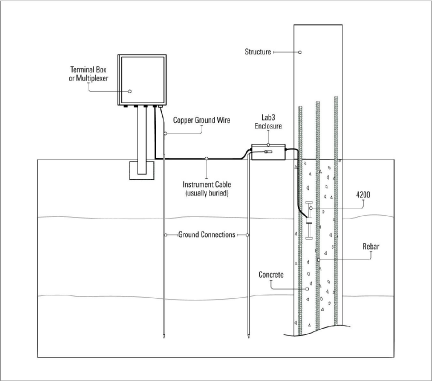4.Instrument Protection
4.1Cable Splicing and Termination
Terminal boxes with sealed cable entries are available from geokon for all types of applications. These allow many instruments to be terminated at one location with complete protection of the lead wires. The interior panel of the terminal box can have built-in jacks or a single connection with a rotary position selector switch. Contact geokon for specific application information.
Because the vibrating wire output signal is a frequency rather than a current or voltage, variations in cable resistance have little effect on instrument readings; therefore, splicing of cables has no ill effects, and in some cases may in fact be beneficial. The cable used for making splices should be a high quality twisted pair type, with 100% shielding and an integral shield drain wire. When splicing, it is very important that the shield drain wires be spliced together. Always maintain polarity by connecting color to color.
Splice kits recommended by geokon incorporate casts that are placed around the splice and are then filled with epoxy to waterproof the connections. When properly made, this type of splice is equal or superior to the cable in strength and electrical properties. Contact geokon for splicing materials and additional cable splicing instructions.
Terminate a cable by stripping and tinning the individual conductors and then connecting them to the patch cord of a readout box. Alternatively, use a connector to plug directly into the readout box or to a receptacle on a special patch cord.
4.2Protection From Electrical Noise
Be sure to install instrument cables as far away as possible from sources of electrical interference such as power lines, generators, motors, transformers, arc welders, etc. Cables should never be buried or run with AC power lines. Doing so will cause the instrument cables to pick up the frequency noise from the power cable, and this will likely make obtaining a stable reading difficult.
Unlike numerous other types of instrumentation available from geokon, vibrating wire strain instruments do not have any integral lightning protection components, such as transorbs or plasma surge arrestors.
Suggested Lightning Protection Options:
■Lighting arrestor boards and enclosures are available from geokon. These units install where the instrument cable exits the structure being monitored. The enclosure has a removable top to allow the customer to service the components or replace the board in the event that the unit is damaged by a lightning strike. A connection is made between the enclosure and earth ground to facilitate the passing of transients away from the instruments. See the figure below.
■Plasma surge arrestors can be epoxied into the instrument cable, close to the instrument. A ground strap then connects the surge arrestor to an earth ground, such as a grounding stake or the steel structure.
Consult the factory for additional information on available lightning protection.
12:

Figure 12: Lightning Protection Scheme